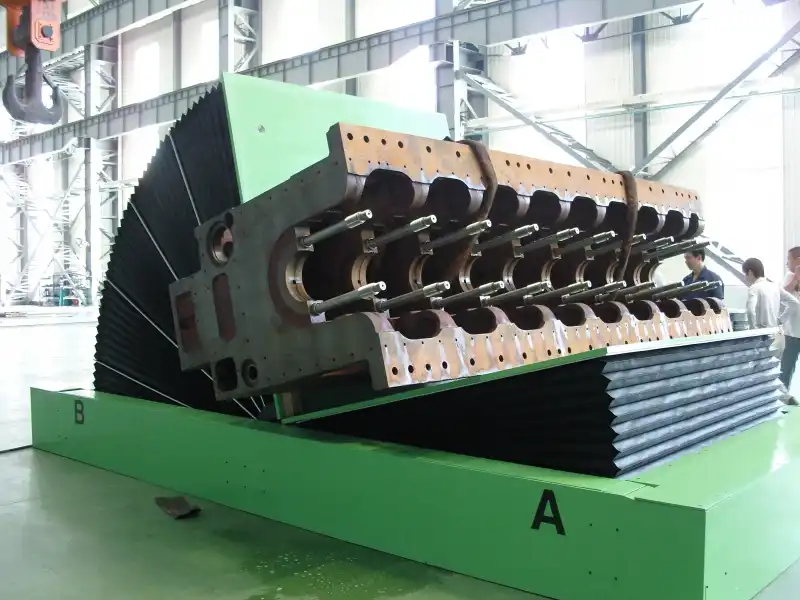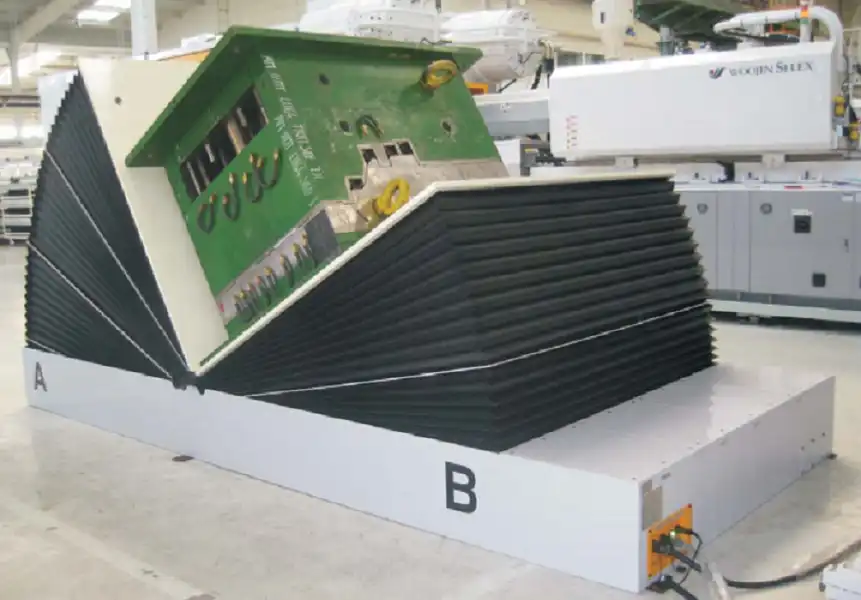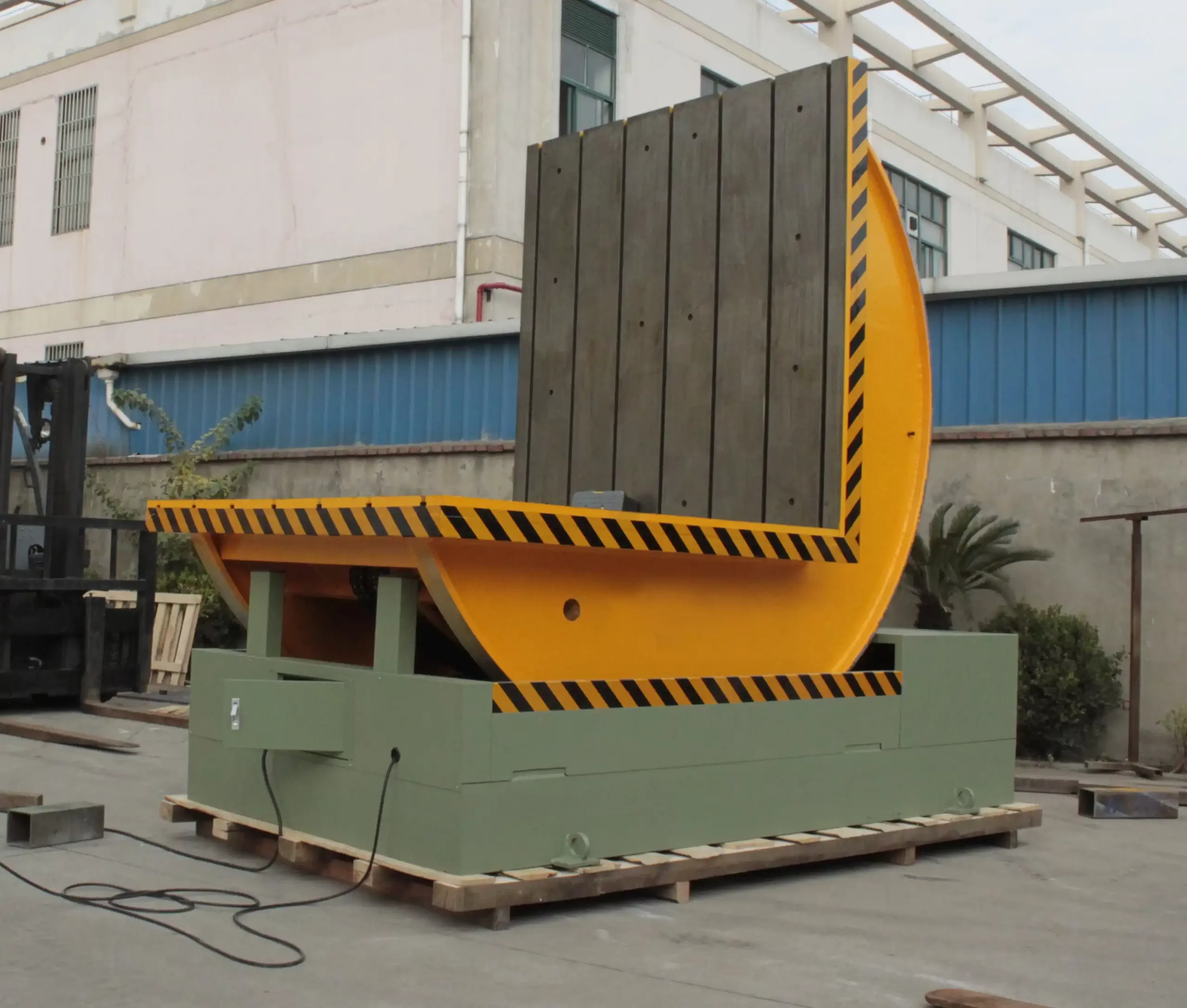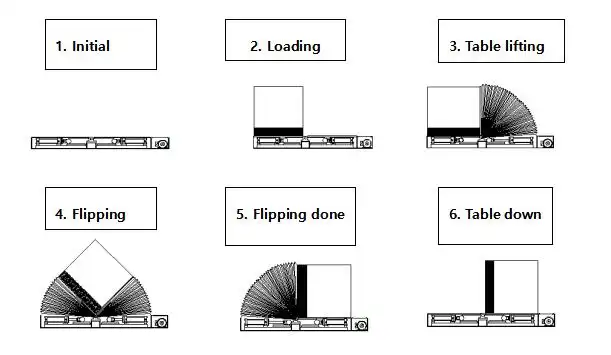Mold Flipper: How Do Thai Plants Improve Safety and Operator Ergonomics Quickly?
Handling heavy, multi-ton molds is a daily reality in many manufacturing plants. But this routine task carries significant risks. A suspended load from a crane can swing unexpectedly. An improperly secured mold on a forklift can shift and fall. These scenarios can lead to catastrophic accidents, causing severe worker injuries, damaging expensive molds, and halting production for days or even weeks. I’ve seen the aftermath of these incidents during my years in the industry, and the costs, both human and financial, are always staggering. This constant worry about safety and the inefficiency of traditional handling methods is a major headache for plant managers. But I’ve seen how plants in Thailand are tackling this problem head-on with a surprisingly simple yet powerful solution: the mold flipper.
Thai plants quickly improve safety and operator ergonomics by implementing specialized mold flippers. These machines provide a stable, controlled platform to turn heavy molds 90 or 180 degrees. This eliminates the need for dangerous crane and chain operations, drastically reduces the risk of accidents, and replaces strenuous manual labor with simple push-button controls, improving workplace conditions almost overnight.

This solution isn't just a minor upgrade. It’s a fundamental change in how a plant handles its most valuable tooling. It addresses core challenges of safety, efficiency, and worker well-being. For any factory owner or manager, like Javier Morales in the steel industry, who is focused on maximizing uptime and protecting their team, understanding how this technology works is crucial. It’s a strategic investment that pays dividends far beyond its initial cost. Let's dive deeper into how this equipment solves long-standing problems in heavy manufacturing.
Why are traditional mold handling methods a risk to both safety and efficiency?
Have you ever watched a team use a crane to flip a heavy mold? The process is slow, requires multiple skilled operators, and is filled with moments of high risk. The chains can slip, the load can swing, and one miscalculation can have severe consequences. This reliance on cranes, chains, and forklifts for flipping molds is a common practice, but it's fundamentally flawed. It introduces unnecessary dangers into the workflow and creates significant inefficiencies that slow down the entire production cycle. The constant potential for accidents and the accepted slowness of the process are hidden costs that eat away at a plant's profitability and safety record.
Traditional mold handling methods, primarily using cranes or forklifts, are risky because they create unstable suspended loads. These methods lack precise control, leading to a high potential for accidents that can injure operators and damage equipment. They are also inefficient, requiring significant time, space, and skilled labor for a single operation, which creates production bottlenecks.

A Closer Look at the Dangers
The primary issue with using a crane is the lack of stability. A mold hanging from chains has a high center of gravity and can easily start to swing or rotate uncontrollably. The riggers must work in close proximity to this massive, unstable load to guide it, putting them in a very dangerous position. A forklift is no better. While it operates on the ground, balancing a multi-ton mold on its forks during a turning operation is incredibly precarious. The mold can easily slide off, especially if the floor is uneven or oily. I once visited a factory where a brand-new injection mold, worth over $100,000, was irreparably damaged when it slipped from a forklift during a clumsy turning attempt. The financial loss was huge, but they were lucky no one was hurt. These methods depend heavily on operator skill and judgment, making them prone to human error.
| Handling Method | Primary Safety Risk | Efficiency Concern | Skill Requirement |
|---|---|---|---|
| Crane & Chains | Uncontrolled swinging; dropped loads | Slow setup and operation; large clear area needed | High (Certified Rigger/Crane Operator) |
| Forklift | Tipping or sliding of the mold | High risk of mold damage; requires precise maneuvering | High (Experienced Forklift Operator) |
| Manual Prying | Crushing injuries; muscle strain | Extremely slow; only for very small molds | Moderate (High physical toll) |
The Unseen Costs of Inefficiency
Beyond the obvious safety risks, these traditional methods are killers of productivity. A single mold flip using a crane can take 20-30 minutes and tie up the crane, a crane operator, and one or two riggers. During this time, that overhead crane cannot be used for any other task, creating a significant bottleneck in the plant's workflow. If you need to perform maintenance or changeovers on multiple molds a day, this lost time adds up quickly. This directly impacts goals like Javier's of increasing equipment uptime to 95%. Every minute the production line is waiting for a mold is a minute of lost output and lost revenue. The process is slow, labor-intensive, and disrupts the entire flow of production. It's an outdated process that has no place in a modern, efficient factory.
How does a mold flipper directly enhance operator safety?
Imagine your maintenance area. A heavy mold needs to be opened for cleaning. Instead of calling for a crane and a team of riggers to perform a dangerous suspended lift, a single operator moves the mold onto a steel table. They step back to a safe distance, push a button on a control panel, and watch as the machine smoothly and securely rotates the mold 90 degrees in under a minute. There are no swinging chains, no risk of a dropped load, and no one is standing in a danger zone. This is the new reality that a mold flipper introduces.
A mold flipper enhances operator safety by securing the mold to a stable platform before rotation. This eliminates the risk of suspended loads associated with cranes. The entire process is controlled from a safe distance via a remote or pendant control, removing the operator from the immediate danger zone and preventing crushing or impact injuries.

A Foundation of Stability
The core safety advantage of a mold flipper, also known as a mold tilter or upender, comes from its fundamental design. Unlike a crane that lifts and suspends, a mold flipper keeps the load supported and controlled at all times. The mold is placed on a heavy-duty table, or between two tables, and is secured. The machine then uses powerful hydraulic or electromechanical systems to execute a smooth, predictable rotation. The center of gravity is managed by the machine's structure, not by swinging chains. This completely removes the single greatest danger of traditional methods: the unstable, suspended load. The operator is no longer a rigger trying to wrestle a multi-ton object into position. They become a system supervisor, initiating a controlled, automated process from a safe location.
Built-in Safeguards and Controls
Modern mold flippers are designed with multiple layers of safety features. This is something I always emphasize when consulting with clients like Javier, who value robust engineering. These are not just simple tilting tables; they are sophisticated pieces of safety equipment.
- Mechanical Locking: Positive locking systems ensure that the machine cannot operate unless the mold is properly positioned and that it will hold its position in case of a power failure.
- Limit Switches: These switches define the start and end points of the rotation, preventing over-travel and ensuring the machine stops exactly at 0 and 90 (or 180) degrees.
- Emergency Stops: E-stop buttons are placed on the machine and the control pendant, allowing the operator to halt all motion instantly if they see a problem.
- Perimeter Guarding: Options for safety railings or light curtains can create a protected zone around the machine, automatically stopping the operation if a person enters the area.
| Safety Feature | Risk Mitigated |
|---|---|
| Stable Platform Base | Dropped loads, uncontrolled swinging |
| Remote/Pendant Control | Operator exposure to crush/impact zones |
| Mechanical/Hydraulic Locks | Unintended movement during power loss |
| Emergency Stop Buttons | Allows immediate halt in any situation |
By engineering the risk out of the process, a mold flipper transforms a high-hazard task into a safe, routine operation. This not only prevents accidents but also reduces the stress and anxiety operators feel when performing their duties, leading to a better and safer work environment for everyone.
What ergonomic benefits does a mold flipper offer to operators?
Think about the physical toll of traditional mold handling. Riggers are constantly pulling on heavy chains, using pry bars, and working in awkward, bent-over positions to guide and secure a load. Forklift operators are craning their necks for long periods. It's physically demanding work that leads to chronic back pain, shoulder injuries, and muscle strain. These musculoskeletal issues are a leading cause of worker compensation claims and lost workdays. It's a slow drain on both your workforce's health and your company's finances. An operator in pain is not a productive or focused operator.
A mold flipper offers significant ergonomic benefits by replacing strenuous physical labor with simple push-button operation. It eliminates the need for operators to manually push, pull, or pry heavy molds, reducing the risk of musculoskeletal injuries like back strain and shoulder damage. The operator can stand upright in a comfortable position while controlling the entire process.

From Physical Strain to Push-Button Control
The most immediate ergonomic benefit is the elimination of manual force. A mold flipper does all the heavy work. The task of turning a 10-ton mold is reduced to pushing a button on a handheld pendant or a fixed control panel. This is a game-changer for operator well-being. Instead of a team of people physically maneuvering the mold, one person can oversee the automated process. This shift from physical labor to machine operation has a profound impact.
A Better Way to Work
Let's break down the ergonomic improvements further. The design of a mold flipper simplifies the entire workflow, reducing both physical and cognitive strain.
- Improved Posture: Operators are no longer required to bend, crouch, or reach in awkward ways. They can stand upright at a control station, maintaining a neutral and safe posture. This drastically reduces the cumulative strain on the back, neck, and shoulders. In my experience, plants that adopt this technology see a noticeable drop in reports of back and shoulder pain among their maintenance crews.
- Reduced Repetitive Motion: The repetitive actions of throwing chains, tightening binders, and guiding loads are completely eliminated. These motions, performed day after day, are a primary cause of repetitive strain injuries (RSIs). A mold flipper replaces these high-risk movements with a single, low-impact action: pressing a button.
- Lower Cognitive Load: A complex crane lift requires intense focus, constant communication, and critical judgment from multiple people. It's mentally fatiguing. A mold flipper automates the most difficult part of the task. The operator's job becomes simpler: ensure the area is clear and initiate the pre-programmed machine cycle. This reduces stress and the chance of human error born from mental fatigue. The process becomes predictable, repeatable, and far less demanding on the operator.
For a leader like Javier, who understands that a healthy, capable workforce is essential for stable production, these ergonomic benefits are just as important as the safety improvements. It's about creating a sustainable work environment where experienced employees can remain productive for longer, without their health suffering from the physical demands of the job.
How can a mold flipper be implemented quickly for immediate results?
When a plant manager like Javier considers a new piece of equipment, two questions are always top of mind: "How much will it disrupt my current operations?" and "How soon will I see a return on my investment?" The fear of a long, complicated installation process that requires shutting down a part of the plant can be a major barrier to adopting new technology. Many large machine installations require extensive civil work, like pouring new concrete foundations, which means significant downtime and cost overruns. This is where the mold flipper truly shines.
A mold flipper can be implemented quickly because most models are self-contained, "plug-and-play" units. They typically do not require special foundations and can be installed on a flat, solid concrete floor. The process involves positioning the machine, connecting it to a power source, and conducting a short training session, allowing plants to see safety and efficiency improvements within days of delivery.

A Straightforward Installation Process
One of the best features of a standard mold flipper is its simple installation. Unlike complex systems that need to be integrated deep into a production line, most mold flippers are standalone machines. I’ve overseen many of these installations, and the process is refreshingly fast.
- No Special Foundation Needed: For most standard capacities, a mold flipper can be placed directly on an existing reinforced concrete factory floor. It is secured with anchor bolts. This eliminates the time and expense of digging pits and pouring new concrete, which can delay a project by weeks.
- Simple Utility Connections: The machine requires a single electrical connection to power the motor and control system. There are no complex networks of pipes or wires to run. An in-house electrician can typically have it connected and powered up in just a few hours.
- Minimal Disruption: Because the installation is so simple, it can often be completed in a single shift, or even over a weekend. The impact on the surrounding production or maintenance areas is minimal. You don't need to shut down the whole department to get the new equipment in place.
Rapid Training and Adoption
A machine is only useful if your team knows how to use it safely and effectively. The intuitive nature of a mold flipper makes training incredibly fast. The controls are usually very simple: a pendant with buttons for "turn forward," "turn reverse," and an "emergency stop." We find that operators can become proficient and confident in using the machine in less than an hour of hands-on training. This quick adoption is key to realizing the benefits immediately. There's no long learning curve or period of low productivity as the team gets used to a complex new system. From day one, your team is working more safely and efficiently. This rapid path from delivery to full operational use is why Thai plants, and others around the world, are seeing such quick improvements. It’s a solution that starts paying for itself almost immediately.
| Implementation Phase | Typical Duration | Key Activities |
|---|---|---|
| Site Preparation | 1-2 Hours | Confirm floor is level and clear the installation area. |
| Delivery & Positioning | 2-4 Hours | Unload the machine and position it with a forklift or crane. |
| Installation | 2-4 Hours | Secure the machine with anchor bolts, connect electrical supply. |
| Training & Handover | 1 Hour | Train operators on safe use, test all functions. |
| Total Time to Operation | ~ 1 Day | From delivery to a fully functional, safer workflow. |
What is my insight on choosing the right mold flipper for your plant?
Over my career, I've seen factories invest in equipment that was either too small for their future needs or overly complex for their actual tasks. Buying a machine is easy; buying the right machine is what requires experience and foresight. When I work with clients, I don't just sell them a product from a catalog. My goal is to provide a total solution, and that starts with understanding their unique operational reality. Choosing a mold flipper is no different. It's not just about turning a mold; it's about integrating a tool that will enhance your entire maintenance and production workflow for years to come.
My insight is that choosing the right mold flipper is less about the machine itself and more about finding a partner who understands your specific application. You must look beyond the base price and consider customization options, load capacity for your heaviest molds, the required turning angle, and the quality of after-sales support. The best investment is a machine tailored to your exact needs.
It's a Partnership, Not a Purchase
When you're making a capital investment, especially one related to safety and core operations, you need more than a supplier. You need a strategic partner. This is a principle I built my own company, SHJLPACK, on. A good partner will ask probing questions to understand your challenges. For a plant manager like Javier, whose challenges include aging equipment and a drive for higher efficiency, the conversation shouldn't start with "What model do you want?" It should start with "Let's talk about your molds."
What are the dimensions and weight of your largest and smallest molds? What is your maintenance workflow? Do you need a 90-degree turn for inspection or a 180-degree turn to separate mold halves? Do you need to integrate the flipper with a conveyor system or a die cart? The answers to these questions will determine the right machine specification. A partner will help you think through these details and even suggest customizations—like a V-shaped table for cylindrical objects or integrated hydraulic clamps—that can make the machine even more effective for your plant.
Key Questions to Guide Your Decision
To ensure you make a wise investment, you must analyze your needs carefully. Here are the critical questions I advise every potential buyer to answer before making a decision. This is the same checklist I use when designing a solution.
- What is your maximum load? Always choose a capacity that is at least 20-25% higher than your heaviest mold. This provides a safety margin and accounts for future needs.
- What are the dimensions of your workpiece? The table size of the flipper must be able to safely accommodate your largest mold's length, width, and height.
- What is the required turning angle? Most maintenance requires a 90-degree turn. However, some processes need a full 180-degree flip. Be clear about your operational requirements.
- What control system is best for you? A simple handheld pendant is standard. But do you need a wireless remote for greater flexibility, or a fixed panel for a dedicated workstation?
- What are the maintenance requirements? A well-designed machine should require minimal maintenance—regular lubrication and inspections. Ask for a clear maintenance schedule.
Thinking through these points ensures you acquire a tool that is perfectly suited to your operation. It prevents you from overspending on features you don't need or, worse, buying a machine that can't handle your most critical tasks. This thoughtful approach is the key to a successful implementation and a quick return on investment.
Conclusion
Investing in a mold flipper is a direct investment in your plant's safety, efficiency, and profitability. It's a simple change with a massive, immediate impact on your daily operations.




